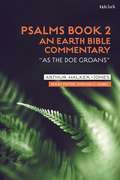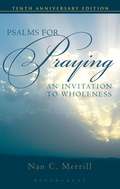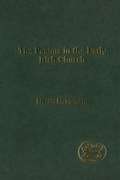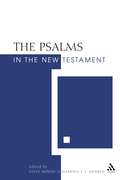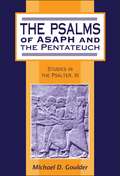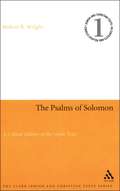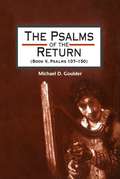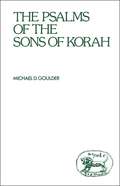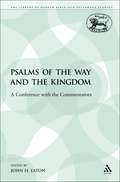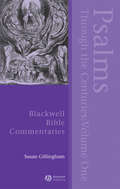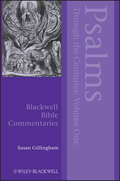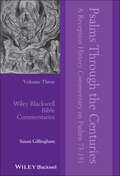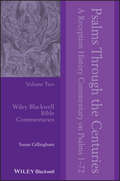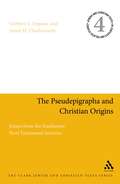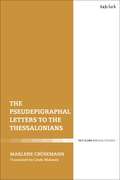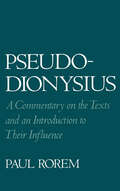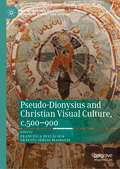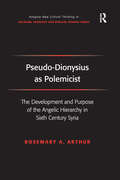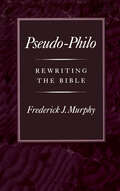- Table View
- List View
Psalms Book 2: “As a Doe Groans” (Earth Bible Commentary)
by Arthur Walker-JonesArthur Walker-Jones presents an Earth-focused reading of the second book of Psalms, focusing upon the many nonhuman animals that appear repeatedly within the text. In the first commentary to explore the implications of the natural and cultural history of animals for the interpretation of Psalms, Walker-Jones moves beyond the standard treatment of animals as mere metaphors for human concerns, or background to human stories. Instead, Walker-Jones draws upon the interdisciplinary field of animal studies, incorporating this into ecocritical analysis and arguing for the similarity between the two approaches, including recognizing that the oppression and liberation of humans is interrelated with the oppression and liberation of Earth and all its creatures. Walker-Jones looks at foxes, sheep, goats, cattle, doves, snakes, lions, snails, dogs, and deer, which all appear in Psalms 42–72, taking into account that many of these animals co-evolved with humans and created the particular ecological niche of the highlands east of the Mediterranean. Perceiving Earth in various ways-as refuge, as enemy, as Rock, and as fertile and joyous-this volume brings an entirely new ecological perspective to the Psalms.
Psalms for Praying: An Invitation to Wholeness
by Nan C. MerrillEvery commentary on the Book of Psalms has had to face the issue that many of these prayers commemorate and celebrate wrath and vengeance. What is needed is not ingenious exegetical rationalization of ancient texts, but the kind of transformation into a work of piety and art that is provided here.Addressed are the needs of a world seeking to counter individual and societal injustices by a global peace born of personal peace through prayer and practice. In short, here is the Book of Psalms recast in the light of the continuing revelation and evolution of the authentic religious spirit of the scriptures.
The Psalms in the Early Irish Church (The Library of Hebrew Bible/Old Testament Studies)
by Martin J. McNamaraA creative, independent, Irish exegetical tradition was well established by the year 700 CE, influencing Northumbria but not Continental Europe. This book contains eight studies by the distinguished Irish biblical scholar, Martin McNamara, which he has published over the past twenty-five years, on the Latin biblical texts (Vulgate, Gallicanum and Jerome's Hebraicum) of the Psalter and commentaries on it in Ireland from 600 CE onwards. The oldest Irish Vulgate text, the Cathach of St Columba of Iona (died 597), shows signs of correction against the Irish recension of the Hebrew text. The central exegetical tradition is strongly Antiochene, being dependent on the commentary of Theodore of Mopsuestia (in Julian's translation), while another branch understands the Psalms as principally about David, rather than christologically or as about later Jewish history.
The Psalms in the New Testament
by Steve Moyise Maarten J.J. MenkenThis book offers a comprehensive summary of the use of the Psalms at Qumran and in the New Testament. For the first time this collection offers a set of studies which will offer an overview of the role and function of the Psalms in the first century. Each chapter considers matters of textual form, points of particular interest, and hermeneutics. Together, this collection forms an important research tool for Septuagintal and manuscript studies, first-century hermeneutics and the development of Christian apologetics and theology. The contributors have all either written or are writing monographs on their particular section of the New Testament/ Qumran. In a number of cases, the particular chapter will be the first of its kind (such as Steve Moyise's discussion of Psalms in Revelation).
The Psalms of Asaph and the Pentateuch: Studies in the Psalter, III (The Library of Hebrew Bible/Old Testament Studies)
by Michael D. GoulderThe Asaph psalms (50, 73-83) are a unity. They often call God 'Elohim' and 'El', and the people 'Joseph', as Amos does; they appeal to Israelite history, the exodus and the covenant; they are written in the face of military catastrophe. In this suggestive and brilliant work, Goulder argues that they were composed in Bethel in the 720s for use as the psalmody for the autumn festival. This gives us vital new evidence for the history of the Pentateuch: there was at Bethel a historical tradition from at least the time of the oppression in Egypt to the Solomonic Empire; the Asaphites took this tradition to Jerusalem and their descendants were the Deuteronomists.
Psalms of Solomon: A Critical Edition of the Greek Text (Jewish and Christian Texts)
by Robert B. WrightThe Psalms of Solomon, the most important early psalm book outside the canonical psalter, reflects the turmoil of events in the last pre-Christian century and gives an apparently eyewitness account of the first invasions of the Romans into Jerusalem. The Psalm of Solomon provides the most detailed expectation of the Jewish Messiah before the New Testament. Wright's critical edition is the first complete critical edition of the Greek texts of the Psalms of Solomon.
The Psalms of the Return: Studies in the Psalter, IV (The Library of Hebrew Bible/Old Testament Studies)
by Michael D. GoulderBook V of the Psalter (Psalms 107-150) divides into three, with the Songs of the Ascents (120-134) as the central section, and the first and third units following parallel structures (historical, Davidic, alphabetical, Hallel psalms). The units are all compositions of the Return period: 107-119 for the reconstruction of the Temple, 120-134 for Nehemiah's wall-building, 135-150 for Ezra's mission. Psalms 120-134 follow the episodes of Nehemiah's 'memoir', in order. All three groups show evidence of evening-morning alternation, and were intended for festal use: 107-118 at the Passover of Ezra 6, 120-134 at the Tabernacles of Nehemiah 12, 135-150 at Ezra's Tabernacles (Neh. 8).
The Psalms of the Sons of Korah (The Library of Hebrew Bible/Old Testament Studies #20)
by Michael D. GoulderIn this innovative study, a different approach to the study of the Psalms from that represented by form criticism is attempted. What is determinative here is the context given to the psalms in their positions in the Psalter: that is, the collections in which they are gathered, the order in which they stand, and the technical notes (Maskil, Selah, and the like) in the text. The application of this approach to one group of psalms, the psalms of the sons of Korah (42-49, 84-85, 87-88 + 89), results in the theory, developed with the author's characteristic flair and originality, that the Korah psalms stand in their original order as the liturgy of the national festival at the Danite sanctuary. Its many fresh and persuasive exegetical suggestions make this work an essential acquisition for the student of the Psalter.
Psalms of the Way and the Kingdom: A Conference with the Commentators (The Library of Hebrew Bible/Old Testament Studies)
by John H. EatonJohn Eaton, well known for his Psalms commentary, here offers a new model of commentary-writing. The psalms treated are those exalting God's Torah (Psalms 1, 19, 119) and those proclaiming his kingship (93, 97, 99). A detailed examination is made of the treatment of these psalms by selected exegetes from Delitzsch to the present. General conclusions are then drawn for such questions as dating, text, unity, meaning, piety, theology, and relation to prophecy. Both groups of psalms are found to contain great riches of religious insight and experience, which exegetes have rarely come within range of appreciating. Several important interpreters are only superficially known outside their own language group; the present study seeks to remedy this.
Psalms Through the Centuries (Wiley Blackwell Bible Commentaries #36)
by Susan GillinghamThis is the first of a two-volume bible commentary covering the Psalms and examining the role of these biblical poems throughout Jewish and Christian history. Provides a fascinating introduction to the literary, historical, and theological background of psalmody Examines the psalms through liturgy and prayer, study and preaching, translation and imitation, and musical composition and artistic illustration Includes illustrations of significant psalms, helpful maps, and an extensive bibliography; an expanded bibliography to accompany the book is also available at www.wiley.com/go/gillingham A forthcoming second volume is planned, which will take an alternative psalm-by-psalm approach Now available in paperback, and published in the innovative reception-history series, Blackwell Bible Commentaries
Psalms Through the Centuries (Wiley Blackwell Bible Commentaries)
by Susan GillinghamThis is the first of a two-volume bible commentary covering the Psalms and examining the role of these biblical poems throughout Jewish and Christian history. Provides a fascinating introduction to the literary, historical, and theological background of psalmody Examines the psalms through liturgy and prayer, study and preaching, translation and imitation, and musical composition and artistic illustration Includes illustrations of significant psalms, helpful maps, and an extensive bibliography; an expanded bibliography to accompany the book is also available at www.wiley.com/go/gillingham A forthcoming second volume is planned, which will take an alternative psalm-by-psalm approach Now available in paperback, and published in the innovative reception-history series, Blackwell Bible Commentaries
Psalms Through the Centuries, Volume 3: A Reception History Commentary on Psalms 73 - 151 (Wiley Blackwell Bible Commentaries #36)
by Susan GillinghamThis third volume completes the set of a groundbreaking reception history of the Psalter, the culmination of two decades’ work In Volume Three of Psalms Through the Centuries: A Reception History Commentary on Psalms 73-151, the internationally recognized biblical scholar Professor Susan Gillingham examines the Jewish and Christian cultural and reception history of Books Three to Five of the Psalter. She examines the changing ways in which psalms have been understood in translations and commentaries, liturgy and prayer, study and preaching, music and art, poetic and dramatic performance, and political and ethical discourse. Lavishly illustrated with thirty colour plates, several black and white images and a number of musical scores, this volume also includes a comprehensive glossary of terms for readers less familiar with the subject and a full, selective bibliography complete with footnote references for each psalm. Numerous links to website resources also allow readers to pursue topics at greater depth, and three clearly organized indices facilitate searches by specific psalms or authors, or types of reception for selected psalms. This structure makes the commentary easy to use, whether for private study, teaching or preaching. The book also offers: A one-of-a-kind treatment of the reception history of the psalms that starts where most commentaries end— beginning with the trajectory of the Psalter’s multi-faceted reception over two millennia Specific discussions of both Jewish and Christian responses to individual psalmsPsalms Through the Centuries: A Reception History Commentary on Psalms 73-151, like the previous two volumes, will earn a distinctive place in the libraries of faculties, colleges, seminaries, and religious communities as well as in private collections of students and scholars of biblical studies, theology, and religion.
Psalms Through the Centuries, Volume 3: A Reception History Commentary on Psalms 73 - 151 (Wiley Blackwell Bible Commentaries)
by Susan GillinghamThis third volume completes the set of a groundbreaking reception history of the Psalter, the culmination of two decades’ work In Volume Three of Psalms Through the Centuries: A Reception History Commentary on Psalms 73-151, the internationally recognized biblical scholar Professor Susan Gillingham examines the Jewish and Christian cultural and reception history of Books Three to Five of the Psalter. She examines the changing ways in which psalms have been understood in translations and commentaries, liturgy and prayer, study and preaching, music and art, poetic and dramatic performance, and political and ethical discourse. Lavishly illustrated with thirty colour plates, several black and white images and a number of musical scores, this volume also includes a comprehensive glossary of terms for readers less familiar with the subject and a full, selective bibliography complete with footnote references for each psalm. Numerous links to website resources also allow readers to pursue topics at greater depth, and three clearly organized indices facilitate searches by specific psalms or authors, or types of reception for selected psalms. This structure makes the commentary easy to use, whether for private study, teaching or preaching. The book also offers: A one-of-a-kind treatment of the reception history of the psalms that starts where most commentaries end— beginning with the trajectory of the Psalter’s multi-faceted reception over two millennia Specific discussions of both Jewish and Christian responses to individual psalmsPsalms Through the Centuries: A Reception History Commentary on Psalms 73-151, like the previous two volumes, will earn a distinctive place in the libraries of faculties, colleges, seminaries, and religious communities as well as in private collections of students and scholars of biblical studies, theology, and religion.
Psalms Through the Centuries, Volume Two (Wiley Blackwell Bible Commentaries #36)
by Susan GillinghamPsalms Through the Centuries: Volume Two provides the first ever extensive commentary on the Jewish and Christian reception history of the first two books of the Psalter (Psalms 1-41 and 42-72). It explores the various uses of the Psalms, over two millennia, in translation and commentary, liturgy and prayer, study and preaching, musical composition and artistic illustration, poetic and dramatic imitation, and contemporary discourse. With lavish illustrations, using examples from both music and art, Psalms Through the Centuries: Volume Two offers a detailed commentary on each psalm, with an extensive bibliography, a large glossary of terms, and helpful indices. It is an ideal resource both for students and scholars in the academy and for lay people and ministers in church and synagogue. Psalms Through the Centuries is published within the Wiley Blackwell Commentary series. Further information about this innovative reception history series is available at www.bbibcomm.info
Psalms Through the Centuries, Volume Two (Wiley Blackwell Bible Commentaries)
by Susan GillinghamPsalms Through the Centuries: Volume Two provides the first ever extensive commentary on the Jewish and Christian reception history of the first two books of the Psalter (Psalms 1-41 and 42-72). It explores the various uses of the Psalms, over two millennia, in translation and commentary, liturgy and prayer, study and preaching, musical composition and artistic illustration, poetic and dramatic imitation, and contemporary discourse. With lavish illustrations, using examples from both music and art, Psalms Through the Centuries: Volume Two offers a detailed commentary on each psalm, with an extensive bibliography, a large glossary of terms, and helpful indices. It is an ideal resource both for students and scholars in the academy and for lay people and ministers in church and synagogue. Psalms Through the Centuries is published within the Wiley Blackwell Commentary series. Further information about this innovative reception history series is available at www.bbibcomm.info
The Pseudepigrapha and Christian Origins: Essays from the Studiorum Novi Testamenti Societas (Jewish and Christian Texts)
by James H. Charlesworth Gerbern S. OegemaIn the Seminar "The Pseudepigrapha and Christian Origins" of the "Studiorum Novi Testamenti Societas", chaired from 2000 to 2006 by Professors James H. Charlesworth (Princeton) and Gerbern S. Oegema (McGill), the relation between the Pseudepigrapha and the New Testament has been discussed systematically and intensively in a way never seen before. The Pseudepigrapha investigated included the Old Testament ones and those found in the Qumran as well as the Pseudepigrapha of the New Testament and the ones used in the Early Church. The seminar and its participants, who were all internally renowned experts from around the world, have focused on the use, adaptation, reinterpretation and further development of non-canonical traditions (except for Philo, Josephus, the Essene and early Rabbinic writings) in the canonical writings of Early Christianity. The seminar has met in total five times in various locations, while systematically being arranged around the following topics: The Pseudepigrapha and the Synoptic Gospels, the Gospel of John, the Epistles of Paul, the Other New Testament Writings, and the Revelation of John.
The Pseudepigrapha and Christian Origins: Essays from the Studiorum Novi Testamenti Societas (Jewish and Christian Texts #4)
by James H. Charlesworth Gerbern S. OegemaIn the Seminar "The Pseudepigrapha and Christian Origins" of the "Studiorum Novi Testamenti Societas", chaired from 2000 to 2006 by Professors James H. Charlesworth (Princeton) and Gerbern S. Oegema (McGill), the relation between the Pseudepigrapha and the New Testament has been discussed systematically and intensively in a way never seen before. The Pseudepigrapha investigated included the Old Testament ones and those found in the Qumran as well as the Pseudepigrapha of the New Testament and the ones used in the Early Church. The seminar and its participants, who were all internally renowned experts from around the world, have focused on the use, adaptation, reinterpretation and further development of non-canonical traditions (except for Philo, Josephus, the Essene and early Rabbinic writings) in the canonical writings of Early Christianity. The seminar has met in total five times in various locations, while systematically being arranged around the following topics: The Pseudepigrapha and the Synoptic Gospels, the Gospel of John, the Epistles of Paul, the Other New Testament Writings, and the Revelation of John.
The Pseudepigraphal Letters to the Thessalonians
by Marlene CrüsemannMarlene Crüsemann examines the Thessalonian letters in the context of Jewish-Christian social history; building upon her analysis of 1 Thessalonians, Crüsemann comes to the conclusion that it is post-apostolic epistolary communication, and questions whether it is a letter of Paul and indeed whether it is an early letter. This analysis in turn adds weight to the thesis, propounded by some previous scholars, that the letter is somewhat out of place and may be a later work by another author. Crüsemann subsequently illustrates that 2 Thessalonians, by contrast, revokes the far-reaching social separation from Judaism that characterizes 1 Thessalonians, and thus aims socio-historically at a solidarity with the entire Jewish people. Analysing the concept of the Jews as supposed enemy, the future of the Greek gentile community, and the relationship between the two letters, Crüsemann concludes that the discussion about a "divergence of the ways of Christians and Jews" in early Christian times needs to be realigned.
The Pseudepigraphal Letters to the Thessalonians
by Marlene CrüsemannMarlene Crüsemann examines the Thessalonian letters in the context of Jewish-Christian social history; building upon her analysis of 1 Thessalonians, Crüsemann comes to the conclusion that it is post-apostolic epistolary communication, and questions whether it is a letter of Paul and indeed whether it is an early letter. This analysis in turn adds weight to the thesis, propounded by some previous scholars, that the letter is somewhat out of place and may be a later work by another author. Crüsemann subsequently illustrates that 2 Thessalonians, by contrast, revokes the far-reaching social separation from Judaism that characterizes 1 Thessalonians, and thus aims socio-historically at a solidarity with the entire Jewish people. Analysing the concept of the Jews as supposed enemy, the future of the Greek gentile community, and the relationship between the two letters, Crüsemann concludes that the discussion about a "divergence of the ways of Christians and Jews" in early Christian times needs to be realigned.
Pseudo-Dionysius: A Commentary on the Texts and an Introduction to Their Influence
by Paul Rorem"Dionysius the Areopagite" is the biblical name chosen by the pseudonymous author of an influential body of Christian theological texts, dating from around 500 C.E. The Celestial Hierarchy, The Ecclesiastical Hierarchy, The Divine Names, and The Mystical Theology offer a synthesis of biblical interpretation, liturgical spirituality, and Neoplatonic philosophy. Their central motif, which has made them the charter of Christian mysticism, is the upward progress of the soul toward God through the spiritual interpretation of the Bible and the liturgy. Dionysius continually reminds his readers, however, that all human concepts fall short of the transcendence of God and must therefore be abandoned in negotiations and silence. In this book, Rorem provides a commentary on all of the Dionysian writings, chapter by chapter, and examines especially their complex inner coherence. The Dionysian influence on medieval theology is introduced in essays on specific topics: hierarchy, biblical symbolism, angels, Gothic architecture, liturgical allegory, the scholastic doctrine of God, and the mystical theology of the western Middle Ages. Rorem's book makes these texts more accessible to both scholars and students and includes a comprehensive bibliography of secondary sources.
Pseudo-Dionysius and Christian Visual Culture, c.500–900 (New Approaches to Byzantine History and Culture)
by Francesca Dell’Acqua Ernesto Sergio MainoldiThis book uses Pseudo-Dionysius and his mystic theology to explore attitudes and beliefs about images in the early medieval West and Byzantium. Composed in the early sixth century, the Corpus Dionysiacum, the collection of texts transmitted under the name of Dionysius the Areopagite, developed a number of themes which have a predominantly visual and spatial dimension. Pseudo-Dionysius’ contribution to the development of Christian visual culture, visual thinking and figural art-making are examined in this book to systematically investigate his long-lasting legacy and influence. The contributors embrace religious studies, philosophy, theology, art, and architectural history, to consider the depth of the interaction between the Corpus Dionysiacum and various aspects of contemporary Byzantine and western cultures, including ecclesiastical and lay power, politics, religion, and art.
Pseudo-Dionysius as Polemicist: The Development and Purpose of the Angelic Hierarchy in Sixth Century Syria (Routledge New Critical Thinking in Religion, Theology and Biblical Studies)
by Rosemary A. ArthurThe anonymous theologian known as Pseudo-Dionysius, who was responsible for arranging the angelic hierarchy into nine orders, had a significant influence on mediaeval European mysticism. This book places him in his religious and political context in sixth century Syria, and uncovers the hidden agenda which lies behind his writings. New evidence is presented to establish the dating of the corpus more accurately than has been done before. Rather than analysing the minutiae of Dionysius' thought, Rosemary Arthur focuses on his sources for, and treatment of, the Angelic Hierarchy and the Dazzling Darkness, with a view to ascertaining his motive for writing, his relationship with his opponents and his need to hide his identity.
Pseudo-Dionysius as Polemicist: The Development and Purpose of the Angelic Hierarchy in Sixth Century Syria (Routledge New Critical Thinking in Religion, Theology and Biblical Studies)
by Rosemary A. ArthurThe anonymous theologian known as Pseudo-Dionysius, who was responsible for arranging the angelic hierarchy into nine orders, had a significant influence on mediaeval European mysticism. This book places him in his religious and political context in sixth century Syria, and uncovers the hidden agenda which lies behind his writings. New evidence is presented to establish the dating of the corpus more accurately than has been done before. Rather than analysing the minutiae of Dionysius' thought, Rosemary Arthur focuses on his sources for, and treatment of, the Angelic Hierarchy and the Dazzling Darkness, with a view to ascertaining his motive for writing, his relationship with his opponents and his need to hide his identity.
Pseudo-Philo: Rewriting the Bible
by Frederick J. MurphyThis is a literary and theological study of the Biblical Antiquities of Pseudo-Philo--a long, well-written reinterpretation of the Hebrew Bible written by a Palestinian Jew of the first century C.E. Using the methodologies of redaction and literary criticism, Murphy provides an analysis of the whole of the Biblical Antiquities. After a chapter-by-chapter analysis, Murphy addresses several topics more generally--major characters, major themes, and the historical context of the work. Full concordances to the Latin text are provided to assist future research on Pseudo-Philo. This book will prove an important resource for students of Jewish interpretation of the Bible at the end of the Second Temple period. It also sheds light on Jewish thought of the period regarding covenant, leadership in Israel, women in Israel, relations with Gentiles, divine providence, divine retribution, eschatology, and many other subjects. Furnishing a broad interpretive context for future work on the Biblical Antiquities, this study gives students of the Bible access to an important literary and religious product of first-century Judaism.
